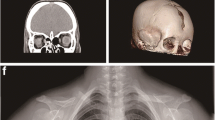Abstract
Cleidocranial dysplasia (CCD) is an autosomal dominant disorder due to mutations in runt-related gene 2 (RUNX2)/polyomavirus enhancer-binding protein 2αA (PEBP2αA)/core-binding factor A1 (CBFA1)/acute myeloid leukemia 3 (AML3). To investigate the RUNX2 mutations in a Japanese patient with classic CCD, we analyzed the RUNX2 gene using polymerase chain reaction (PCR)–single-strand conformation polymorphism and PCR–restriction fragment length polymorphism. The patient had hypoplasia of the clavicles, patent fontanelles, short stature, supernumerary teeth, and retention of deciduous dentition. We identified a 1-bp insertion (383insT) at codon 128 of the RUNX2 gene. The 383T insertion affects the conserved residue in the runt domain and results in premature termination in the runt domain.
Similar content being viewed by others
Author information
Authors and Affiliations
Additional information
Received: November 13, 2000 / Accepted: December 25, 2000
About this article
Cite this article
Goseki-Sone, M., Orimo, H., Watanabe, A. et al. Identification of a novel frameshift mutation (383insT) in the RUNX2 (PEBP2 α/CBFA1/AML3) gene in a Japanese patient with cleidocranial dysplasia. J Bone Miner Metab 19, 263–266 (2001). https://doi.org/10.1007/s007740170030
Issue Date:
DOI: https://doi.org/10.1007/s007740170030




